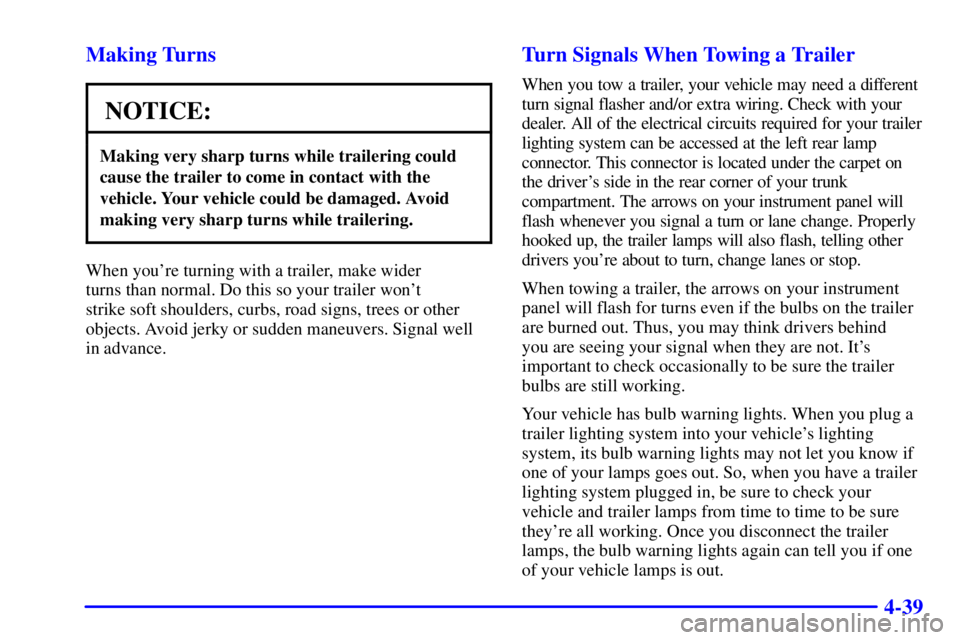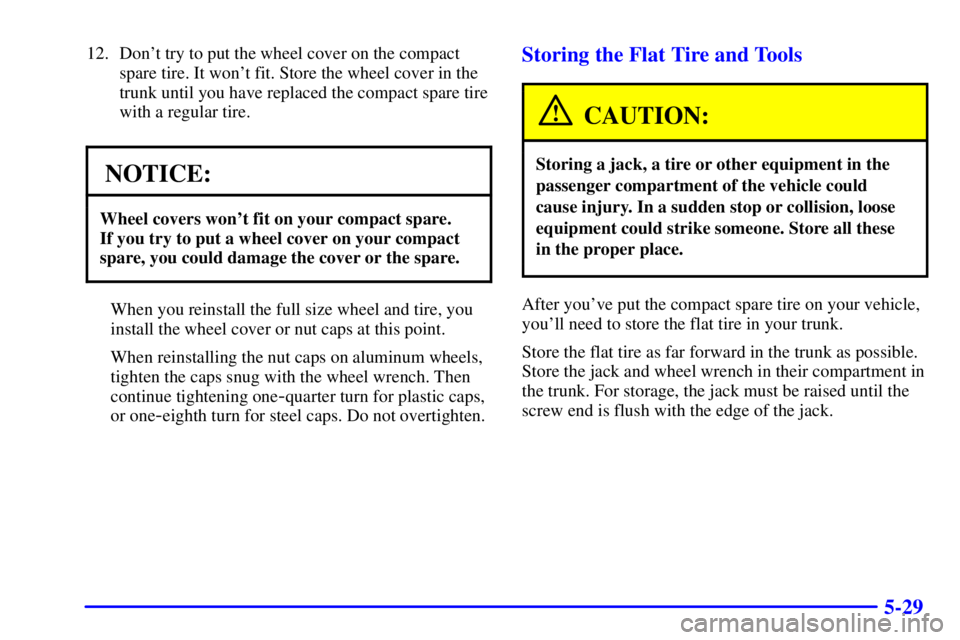Page 261 of 427

4-39 Making Turns
NOTICE:
Making very sharp turns while trailering could
cause the trailer to come in contact with the
vehicle. Your vehicle could be damaged. Avoid
making very sharp turns while trailering.
When you're turning with a trailer, make wider
turns than normal. Do this so your trailer won't
strike soft shoulders, curbs, road signs, trees or other
objects. Avoid jerky or sudden maneuvers. Signal well
in advance.
Turn Signals When Towing a Trailer
When you tow a trailer, your vehicle may need a different
turn signal flasher and/or extra wiring. Check with your
dealer. All of the electrical circuits required for your trailer
lighting system can be accessed at the left rear lamp
connector. This connector is located under the carpet on
the driver's side in the rear corner of your trunk
compartment. The arrows on your instrument panel will
flash whenever you signal a turn or lane change. Properly
hooked up, the trailer lamps will also flash, telling other
drivers you're about to turn, change lanes or stop.
When towing a trailer, the arrows on your instrument
panel will flash for turns even if the bulbs on the trailer
are burned out. Thus, you may think drivers behind
you are seeing your signal when they are not. It's
important to check occasionally to be sure the trailer
bulbs are still working.
Your vehicle has bulb warning lights. When you plug a
trailer lighting system into your vehicle's lighting
system, its bulb warning lights may not let you know if
one of your lamps goes out. So, when you have a trailer
lighting system plugged in, be sure to check your
vehicle and trailer lamps from time to time to be sure
they're all working. Once you disconnect the trailer
lamps, the bulb warning lights again can tell you if one
of your vehicle lamps is out.
Page 285 of 427
5-22 Removing the Spare Tire and Tools
The equipment you'll need is in the trunk.
1. Pull the carpeting from the floor of the trunk.
2. Remove the retainer, then lift and remove the cover.
3. Remove the compact spare tire. See ªCompact Spare
Tireº later in this section for more information about
the compact spare tire.4. Unscrew the wing nuts to remove the container that
holds the wrench and jack.
5. Remove the wheel wrench, jack and the spare tire
from the trunk.
The tools you'll be using include the jack (A) and
wheel wrench (B).
Page 292 of 427

5-29
12. Don't try to put the wheel cover on the compact
spare tire. It won't fit. Store the wheel cover in the
trunk until you have replaced the compact spare tire
with a regular tire.
NOTICE:
Wheel covers won't fit on your compact spare.
If you try to put a wheel cover on your compact
spare, you could damage the cover or the spare.
When you reinstall the full size wheel and tire, you
install the wheel cover or nut caps at this point.
When reinstalling the nut caps on aluminum wheels,
tighten the caps snug with the wheel wrench. Then
continue tightening one
-quarter turn for plastic caps,
or one
-eighth turn for steel caps. Do not overtighten.
Storing the Flat Tire and Tools
CAUTION:
Storing a jack, a tire or other equipment in the
passenger compartment of the vehicle could
cause injury. In a sudden stop or collision, loose
equipment could strike someone. Store all these
in the proper place.
After you've put the compact spare tire on your vehicle,
you'll need to store the flat tire in your trunk.
Store the flat tire as far forward in the trunk as possible.
Store the jack and wheel wrench in their compartment in
the trunk. For storage, the jack must be raised until the
screw end is flush with the edge of the jack.
Page 293 of 427
5-30 Storing the Spare Tire and Tools
CAUTION:
Storing a jack, a tire or other equipment in the
passenger compartment of the vehicle could
cause injury. In a sudden stop or collision, loose
equipment could strike someone. Store all these
in the proper place.
The compact spare tire is for temporary use only.
Replace the compact spare tire with a full
-size tire as
soon as you can. See ªCompact Spare Tireº later in this
section. See the storing instructions label to return your
compact spare into your trunk properly.A. Wrench
B. Jack
C. Jack Container
D. Retainer
E. Compact Spare Tire Cover
F. Retainer
Page 303 of 427
6-8 Fuel Door Lock (Option)
On models having the optional theft-deterrent system,
the fuel door is locked and unlocked together with the
driver's power door lock. Therefore, to unlock the fuel
filler door, you may use the inside power door lock
button or the remote keyless entry transmitter
(if equipped). To unlock the fuel door, unlock the
driver's door.
If your vehicle has a fuel door lock, the fuel door can be
opened manually in case of an electrical power failure.
The release mechanism is
on the driver's side of the
vehicle, at the top of the
trunk compartment. Pull the
tab to release the fuel door.
NOTICE:
Prying on a locked fuel filler door can damage it.
Use the remote fuel door manual release located
in the trunk in the case of a power failure.
Page 304 of 427

6-9
Filling a Portable Fuel Container
CAUTION:
Never fill a portable fuel container while it is in
your vehicle. Static electricity discharge from the
container can ignite the gasoline vapor. You can
be badly burned and your vehicle damaged if this
occurs. To help avoid injury to you and others:
�Dispense gasoline only into
approved containers.
�Do not fill a container while it is inside a
vehicle, in a vehicle's trunk, pickup bed or
on any surface other than the ground.
�Bring the fill nozzle in contact with the
inside of the fill opening before operating
the nozzle. Contact should be maintained
until the filling is complete.
�Don't smoke while pumping gasoline.
Checking Things Under the Hood
CAUTION:
An electric fan under the hood can start up and
injure you even when the engine is not running.
Keep hands, clothing and tools away from any
underhood electric fan.
CAUTION:
Things that burn can get on hot engine parts and
start a fire. These include liquids like gasoline,
oil, coolant, brake fluid, windshield washer and
other fluids, and plastic or rubber. You or others
could be burned. Be careful not to drop or spill
things that will burn onto a hot engine.
Page 339 of 427
6-44 Rear Turn Signals, Stoplamps, Taillamps
and Back-Up Lamps
A. Back-Up Lamp
B. Turn Signal
C. Taillamp
D. Tail/Brake Lamp
1. Open the trunk. Turn the screws located inside of the
trunk counterclockwise and remove them.
2. Remove the plastic trim piece from the trunk.3. Pull the carpeting away from the rear corner of
the trunk.4. Remove the three nuts holding the lamp in place and
remove the lamp assembly.
5. While pressing the release, turn the bulb socket
assembly counterclockwise to remove it from the
lamp assembly.
6. Pull the bulb straight out from the socket.
7. Replace the bulb and reverse Steps 1 through 6 to
reinstall the lamp assembly.
Page 370 of 427
6-75
Minifuse Usage
23 Not Used
24 Not Used
25 Passenger Door Module
26 Body
27 Interior Lamps
28 Not Used
29 Ignition Switch
30 Instrument Panel
31 Heated Seat Right Front
32 Not Used
33 Heating, Ventilation,
Air Conditioning
34 Ignition 3 Rear
35 Antilock Brake System
36 Turn Signal/Hazard
37 HVAC Battery
38 Dash Integration ModuleMicro Relay Usage
39 Fuel Pump
40 Parking Lamps
41 Ignition 1
42 Rear Fog Lamps
43 Not Used
44 Park Brake
45 Reverse Lamps
46 Retained Accessory Power
47 Fuel Tank Door Lock
48 Not Used
49 Ignition 3
50 Fuel Tank Door Release
51 Interior Lamps
52 Trunk Release
53 Front Courtesy Lamps
54 Not Used
55 Electronic Level
Control Compressor